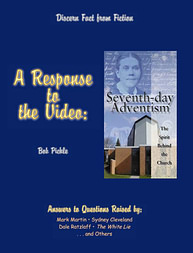|
A Response to the Video:
Seventh-day Adventism, the Spirit Behind the Church
by Bob Pickle
Answers to Questions Raised by:
Mark Martin, Sydney Cleveland
Dale Ratzlaff, The White Lie
. . . and Others
Discern Fact from Fiction
Health Counsel, Wigs, and the Reform Dress
< Prev T. of C. ... 122 123 124 125 126 127 128-129 130 131-136 ... Next >
[The following does not appear in all copies of the video. See the note preceding
#117-#118.]
| #126: "In the famous Battle Creek
Sanitarium, while still under Adventist control, the so-called cure for
secret vice was practiced. 'A sitz bath may be taken... at as low a temperature as can be
tolerated without
chilliness. Give at the same time a hot foot bath, and apply cool wet cloths to the head...
. . .' A Solemn
Appeal p. 271."—Narrator. |
#126: This is the so-called
cure. Thus hydrotherapy, a very potent treatment for a variety of ailments, is
ridiculed.
This treatment isn't even the whole cure. It's only one part of five: "1. Diet
and Regimen. . . . 2.
Sleeping. . . . 3.
Bathing. . . . 4.
Exercise. . . . 5. Social
Surroundings. . . ."—pp. 270-272.
The section this is found in has the heading, "Hygienic Treatment." What does this
term mean? It refers to a particular school of medical
thought. Today we have allopathic medicine, chiropractic medicine, and other modalities of
treatment. Hygienic medicine was yet another one.
Hygienic physicians, such as Dr. E. P. Miller, avoided drug therapy with its side
effects. Besides proper diet and exercise, they used simple
treatments like hydrotherapy.
So what can hydrotherapy do? When used properly, it can relieve congestion, pain,
fever, fatigue, and muscle spasms; increase white blood
cell activity, antibody production, and toxin elimination; and either stimulate or sedate (Dail
and Thomas, Hydrotherapy, Simple Treatments
for Common Ailments 1, 6, 17, 40).
How effective can it be? Mrs. White advised a form of hydrotherapy for a malarial
patient from Allegan, Michigan, who promptly recovered
(Manuscript Releases, vol. 20, p. 279). Physicians at the General
Conference sessions near the turn of the century reported the success they
were having using hydrotherapy for a particular form of malaria. Their success was not
attended with the side effects of drug therapy. Even in
cases when quinine was unsuccessful, the hydrotherapy treatments worked (General
Conference Bulletin, June 1, 1909, p. 236; June 6, p.
324; June 7, p. 357).
As drug resistance in microbes becomes more of a problem, it might be wise to
research the effectiveness of hydrotherapy on yet other forms
of malaria, as well as other diseases.
This writer knows of a physician who periodically has problems with bowel
obstructions, due to scar tissue from previous surgery. She has
treated herself with a particular form of hydrotherapy, and by so doing has recovered without
surgery a number of times. Thus hydrotherapy
rightly used is nothing to ridicule.
(Those who are not sure what "rightly used" means should consult a hygienic
physician. This book is obviously not intended to diagnose
disease or advise a specific medical treatment.)
The documentation package described "Point 66" in the index as
"The Battle Creek cure for 'secret vice' used when EGW and Dr.
Kellogg ran the sanitorium [sic]." The truth is that neither was running the
sanitarium when Solemn Appeal was published in 1870. Kellogg
was still a teenager, and didn't come on board the sanitarium staff until five or six years
later. Mrs. White never ran any institution in the normal
sense of the word. She only sat on one board, and that was of Madison College in Tennessee
after the turn of the century.
The sanitarium was founded in 1866. Between its founding and the publication of
Solemn Appeal, much of that time James and Ellen were
living in northern Michigan, not in Battle Creek. They had moved there to facilitate James's
recovery from the paralytic stroke he had had in
1865. During this same time period, attitudes in Battle Creek were such that Mrs. White
found it difficult to do far less than run an entire
institution (Arthur White, vol. 2, pp. 138, 168-289).
Page 268 of Solemn Appeal makes it clear that the advised course of
treatment was being given by physicians who had treated "a large
number of cases," the great majority of which must have been dealt with while Mrs. White
was nowhere near Battle Creek. But for the video
to have criticized the doctors of that time, whether Adventist or not, wouldn't have helped
build its case against the ghost "behind the church." [p. 88]

|

|
Like this book?
Save your printer and your ink!
Buy the entire 160-page book for
just
$9.95 + S/H.
Automatic discounts start
at 5 copies.
|
|
|
< Prev T. of C. ... 122 123 124 125 126 127 128-129 130 131-136 ... Next >
| 


